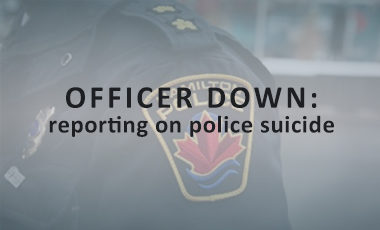Case Studies Collection: reporting on police suicide
When a cop shot himself in a local cemetery, the Hamilton Spectator had to decide what the public should know.
[[{“fid”:”4160″,”view_mode”:”default”,”fields”:{“format”:”default”,”field_file_image_alt_text[und][0][value]”:””,”field_file_image_title_text[und][0][value]”:””},”type”:”media”,”attributes”:{“style”:”width: 400px; height: 242px; margin-left: 10px; margin-right: 10px; float: right;”,”class”:”media-element file-default”},”link_text”:null}]]Inspired in part by the Columbia Journalism School’s Case Consortium, Ryerson University’s School of Journalism has been compiling a database of studies on ethical dilemmas in Canadian journalism since 2012.
Part ethics exercise and part curriculum resource, the case studies have been highlighted on J-Source in the past, regarding coverage of former Toronto mayor Rob Ford and his family in 2013. In an ongoing series, we’ll be highlighting some more of those cases here as they become available.
By Deanne Bender, Sidney Cohen and Jeanie Tran
Early in the afternoon of Nov. 1, 2005, a single shot rang out across the grounds of White Chapel Memorial Gardens, a sprawling cemetery in Hamilton’s west end. Not long after, a panicked radio transmission was picked up by a police scanner in The Hamilton Spectator newsroom: “Officer down.”
Susan Clairmont, a columnist who frequently covered crime and the courts for The Spectator, heard the call. The newsroom quickly mobilized. They knew from the call that there was an officer in crisis—nothing more.
A photographer was immediately sent to the scene. In the meantime, Clairmont and another crime reporter gathered with senior and city editors to assess the situation and determine their next move.
Piece by piece, more information came out. One man had been killed. It was a plainclothes police officer. He had been found inside a police vehicle—an unmarked silver sedan. Police said they would not be investigating the incident. What had happened?
From the cemetery, the photographer reported first responders on the scene and police officers who were noticeably upset. The Spectator newsroom quickly decided that it needed more information to determine whether to publish the story. Clairmont took charge of the assignment.
“There were quite a few of us in there to have a discussion about what, if anything, we were going to publish about this apparent suicide of a police officer,” says Clairmont. “It was a long conversation, and sometimes heated, or passionate. People had very different views on how we should cover it, if at all.”
Over the course of the day, many people in the newsroom were involved in the debate. Other vocal participants in the conversation were Jim Poling, The Spectator’s assistant managing editor and now managing editor; Roger Gillespie, the managing editor; and Dana Robbins, the newspaper’s editor-in-chief.
As reporting got underway, more details of the event began to unfurl. The officer had been on duty at the time of his death. He worked in the Investigative Services Division, and at 45 years old, he was a veteran of the force. The gunshot that ended his life had come from his own service weapon.
The newspaper found itself faced with a dilemma: did this instance of suicide warrant newspaper play? Yes, the deceased was an on-duty police officer. But under his uniform this officer was a person—one who had clearly suffered mentally and emotionally. His death was a tragedy for his family, and the force. Some said it was a private matter, case closed.
Still, many questions remained unanswered. According to Poling, the newsroom learned that the officer’s death was a suicide through “unofficial channels.” That raised yet another dilemma for the journalists involved. As Poling puts it: “How do you prove that? How do you get that on the record? How do you know? Particularly with suicides—and police suicides—at that time, the typical response was, ‘We don’t talk about it.’”
Clairmont and Poling knew they needed to act on this incident, and fast, to meet the publication deadline for the next day’s paper. The question was: What could they report, and how could they do it truthfully and responsibly?
To read the rest of this case study, please head to the Case Studies Collection, where it was originally published.
Because these case studies are intended primarily as a teaching resource, a password is required to view the epilogue of each case. The purpose is to encourage readers to pause and think about how they would resolve the difficulty, without knowing how the journalist(s) involved did so. Password access will be provided to any teacher, or to others for information, with a request that the epilogue not be republished. Copyright on each case study is owned by its authors. Copyright on the compilation as a whole: Ryerson University, 2014.

